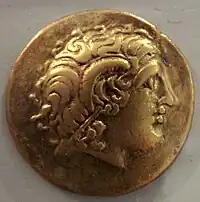The Mandubii (Gaulish: *Mandubioi) were a small Gallic tribe dwelling near their chief town Alesia, in modern Côte-d'Or, during the Iron Age and the Roman period.
Name
An oppidum Mandubiorum is mentioned by Caesar (mid-1st c. BC),[1] and the tribe is designated as Mandoubíōn (Μανδουβίων) by Strabo (early 1st c. AD).[2][3]
The ethnonym Mandubii is a latinized form of Gaulish *Mandubioi (sing. *Mandubios). It is generally seen as stemming from the root mandu- ('pony').[4][5] Alternatively, Pierre-Yves Lambert has proposed to compare the name with the Welsh mathru ('trample upon').[6] The second element may be related to the second element of the vulgar Latin vidubium 'billhook' (a loan from Gaulish) and mean 'beaters' or 'strikers'.
Geography
The territory of the Mandubii was located in the Haux-Aixois region, between the settlements of Alesia in the north, Blessey in the east, Braux in the west, and Sombernon in the southeast.[7] During the reign of the Roman emperor Augustus, their small territory was incorporated into the Lingonian territory.[8] In the unstable period following the death of Nero in 68 AD, the Mandubii were excluded from the Lingonian territory and attached to the Aedui.[7]
History
Mandubian ceramics are attested in Villaines-les-Prévôtes by the 2nd century BC. While under the influence of the neighbouring and more powerful Aedui and Lingones, the Mandubii benefited from a relative autonomy (at least economic and cultural) before the Roman conquest.[9]
References
- ↑ Caesar. Commentarii de Bello Gallico, 7:68:1.
- ↑ Strabo. Geōgraphiká, 4:2:3.
- ↑ Falileyev 2010, s.v. Mandubii.
- ↑ Evans 1967, pp. 222–223.
- ↑ Delamarre 2003, p. 215.
- ↑ Lambert 1994, p. 36.
- 1 2 Barral, Guillaumet & Nouvel 2002, p. 280.
- ↑ Barral, Guillaumet & Nouvel 2002, p. 279.
- ↑ Barral, Guillaumet & Nouvel 2002, p. 282.
Bibliography
- Barral, Philippe; Guillaumet, Jean-Paul; Nouvel, Pierre (2002). Garcia, D.; Verdin, F. (eds.). "Le territoire des Éduens d'après les dernières découvertes". Territoires celtiques, espaces ethniques et territoire des agglomérations d'Europe occidentale, actes du XXIV° congrès de l'AFEAF, Martigues, 1er - 4 juin 2000. Errance: 271–296.
- Delamarre, Xavier (2003). Dictionnaire de la langue gauloise: Une approche linguistique du vieux-celtique continental. Errance. ISBN 9782877723695.
- Evans, D. Ellis (1967). Gaulish Personal Names: A Study of Some Continental Celtic Formations. Clarendon Press. OCLC 468437906.
- Falileyev, Alexander (2010). Dictionary of Continental Celtic Place-names: A Celtic Companion to the Barrington Atlas of the Greek and Roman World. CMCS. ISBN 978-0955718236.
- Lambert, Pierre-Yves (1994). La langue gauloise: description linguistique, commentaire d'inscriptions choisies. Errance. ISBN 978-2-87772-089-2.
